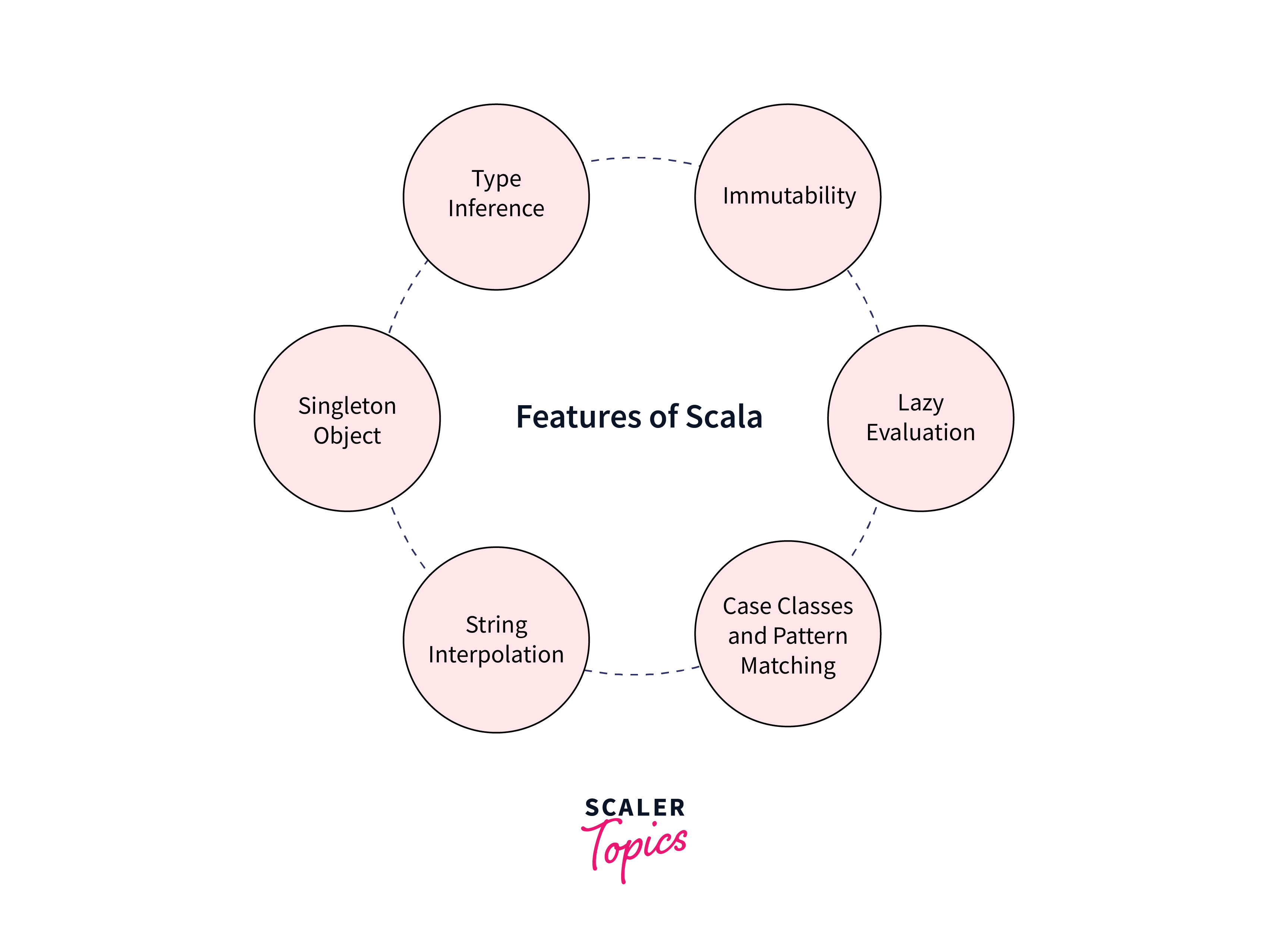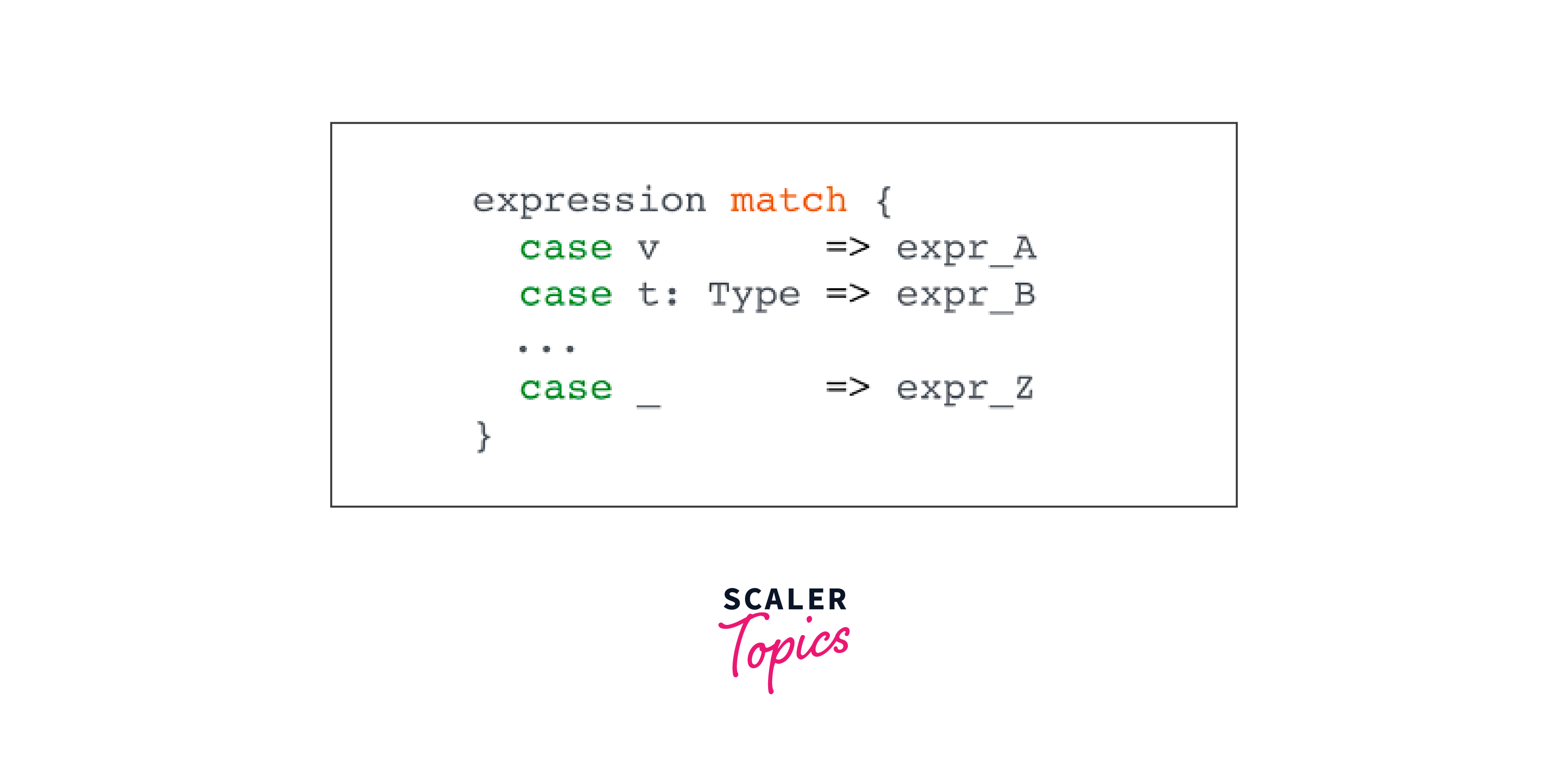Scala Features
Overview
Scala is a powerful programming language that combines functional and object-oriented programming paradigms. It has several features like type inference, immutability, lazy computation, concurrency control and higher order functions etc that make it a popular choice for a wide range of applications.
What are the features of Scala?

Type inference
Type inference in Scala is a powerful feature that allows the compiler to automatically deduce the data types of variables and expressions without the need for explicit type annotations. This feature combines the benefits of static typing, which catches type-related errors at compile-time, with the convenience of concise and readable code.
Here's how type inference works in Scala:
- Variable Declarations: When we declare a variable using the val or var keyword, we can omit the explicit type declaration, and the compiler infers the type based on the value assigned to the variable.
- Function Definitions: Type inference extends to function parameters and return types. We can often omit the type annotations for function parameters and let the compiler determine them.
- Conditional Expressions: In conditional expressions, type inference helps determine the common supertype of different branches.
- Collections: When creating collections like lists, arrays, or maps, type inference allows us to omit type annotations.
Singleton object
In Scala, a Singleton Object is a fundamental and unique construct that combines features of both classes and objects. It is designed to ensure that a single instance of the object is created throughout the lifetime of the application. Singleton objects are often used to encapsulate utility methods, define entry points for an application, or create shared resources.
Here are the key characteristics and use cases of Singleton Objects:
- Singleton Instance:
- Singleton objects are defined using the object keyword, followed by the object's name.
- They are instantiated automatically upon first access, and subsequent accesses refer to the same instance.
- No Constructor:
- Unlike classes, Singleton objects cannot be instantiated using constructors.
- They don't have constructors or constructor parameters.
- Global Accessibility:
- Singleton objects are globally accessible from anywhere in our code.
- We can call methods and access fields of a singleton object without creating an instance.
- Utility Functions:
- Singleton objects are commonly used to encapsulate utility functions, constants, or shared logic that doesn't require instance-specific state.
Immutability
In Scala, immutability entails that once data structures or objects are established, they remain unalterable. Whether it's an immutable variable or data structure such as a list or map, their content cannot be changed. Instead, any desired modifications necessitate the creation of new instances. Key points about immutability in Scala:
- Immutable Variables: When we declare a variable with val, it becomes immutable. We cannot reassign a new value to it after the initial assignment.
- Immutable Collections: Scala offers a robust suite of immutable collections like List, Map, and Set that, when altered, generate new collections with changes while preserving the original collection's integrity.
Lazy computation
Lazy computation, also known as lazy evaluation, is a programming technique used to defer the execution of a computation or the evaluation of an expression until the result is actually needed. In other words, lazy computation delays the work until the moment when it's required, rather than doing it eagerly.
Key points about lazy computation:
- Deferred Execution: Lazy computation defers immediate evaluation of a value or expression until it's first accessed.
- Lazy Keyword: In Scala, 'lazy' as a keyword signals deferred computation, instructing the compiler to evaluate the value only upon first access.
- Performance Optimization: Lazy evaluation improves performance by delaying computation until necessary, reducing unnecessary work when results aren't used.
- Initialization: Lazy evaluation is frequently employed for deferring object initialization until the initial access, optimizing resource utilization.
Case classes and Pattern matching
Case Classes:
Case classes in Scala are a specialized form of classes primarily used for defining and working with immutable data structures. They come with a set of features that simplify common programming tasks, making them well-suited for modeling data in our applications.
Key points about case classes:
- Immutable Data: Case classes are inherently immutable, meaning their instances cannot be modified after creation. This ensures that the data they represent remains unchanged, which is a fundamental principle in functional programming.
- Automated Methods: Case classes automatically generate several methods, such as toString, equals, and hashCode, based on the class's constructor parameters. This simplifies object comparison and debugging.
Pattern Matching:
Pattern matching in Scala is a powerful control structure that allows us to match patterns in data and execute specific code blocks based on those patterns. It is often used with case classes to destructure and process data.

Key points about pattern matching:
- Pattern Matching Expressions: Pattern matching is used as an expression in Scala, similar to a switch statement in other languages but much more expressive and powerful.
- Matching on Case Classes: One of the common use cases for pattern matching is matching on the structure of case class instances.
Concurrency control
Concurrency control in Scala refers to the mechanisms and techniques used to manage and coordinate the execution of concurrent tasks or threads within a program. Scala provides several features and libraries to help developers address concurrency challenges effectively.

Key concepts and approaches for concurrency control in Scala:
-
Actor Model: Scala, using the Akka library, provides an actor-based concurrency model, where lightweight, independent units of computation communicate via message-passing, abstracting low-level thread and synchronization complexities in concurrent and distributed programming.
-
Futures and Promises: Scala employs Future and Promise classes for asynchronous programming, with Futures representing potentially available values in the future, facilitating non-blocking operations, and Promises used to fulfill Futures with values or exceptions.
-
Synchronization: Scala offers synchronization options like synchronized blocks and Java's java.util.concurrent, but higher-level abstractions like actors and futures are often advised for safer and more scalable concurrency control.
String interpolation
String interpolation in Scala is a feature that allows us to embed expressions within string literals, making it easier to create dynamic strings that include the values of variables or the results of expressions. Scala provides several methods for string interpolation, making it a concise and readable way to build strings.
There are three main types of string interpolation in Scala:
- s-Interpolation: To enable string interpolation in Scala, prefix string literals with the letter 's' and include variables or expressions within ${} placeholders for dynamic content insertion.
- f-Interpolation: In Scala, 'f' interpolation, enabled by prefixing string literals with 'f', allows for advanced formatting by specifying placeholders with %, particularly useful for precision and alignment in numeric values.
- raw-Interpolation: In Scala, prefixing string literals with 'raw' creates raw strings, where escape sequences like \n are treated as literals instead of escape codes.
Higher order function
In Scala, a higher-order function refers to a function that has the capability to either accept functions as input parameters or yield functions as its output. Essentially, it treats functions as first-class citizens, allowing us to use them as variables, parameters, or return values. This powerful feature enables us to write more expressive and modular code, facilitating functional programming techniques.
Key points about higher-order functions in Scala:
- Function as a Parameter: We can pass functions as arguments to other functions. These functions are often referred to as "callbacks" or "function parameters".
- Function as a Return Value: Scala allows the creation of closures, functions defined inside other functions that capture their surrounding environment, enabling them to retain and utilize values from the outer scope.
- Built-in Higher-Order Functions: Scala's standard library features higher-order functions like map, filter, reduce, and fold, which utilize user-defined functions to process elements within collections efficiently.
Traits
In Scala, traits are a powerful and flexible mechanism for code reuse and composition. Traits are similar to interfaces in other languages, but they can also contain concrete methods and fields. They enable us to define reusable components that can be mixed into classes, allowing those classes to inherit and use the functionality defined in the trait.
Key points about traits in Scala:
- Mixin Composition: Traits are typically used to mix additional behavior into classes. A class can mix in multiple traits, allowing for flexible code composition.
- Abstract and Concrete Members: Traits can contain both abstract members (methods and fields without implementations) and concrete members (methods with implementations).
Rich collection set
The Rich Collection Library in Scala is a set of enhancements and utilities provided by the Scala standard library to make working with collections more convenient, expressive, and powerful. These enhancements are often referred to as "rich" collection methods because they add functionality and syntactic sugar to the standard collection classes like List, Set, Map, and more.
Conclusion
- Scala combines functional and object-oriented programming, supports type inference, immutability, concurrent programming, and pattern matching, and has seamless Java interoperability.
- Scala offers type inference to automatically deduce the data types of variables and expressions, reducing the need for explicit type annotations.
- Scala provides concurrency to the simultaneous execution of multiple tasks or threads, enabling efficient use of multicore processors.
- Lazy computation in Scala defers the execution of code until the result is needed, optimizing performance and resource utilization.
